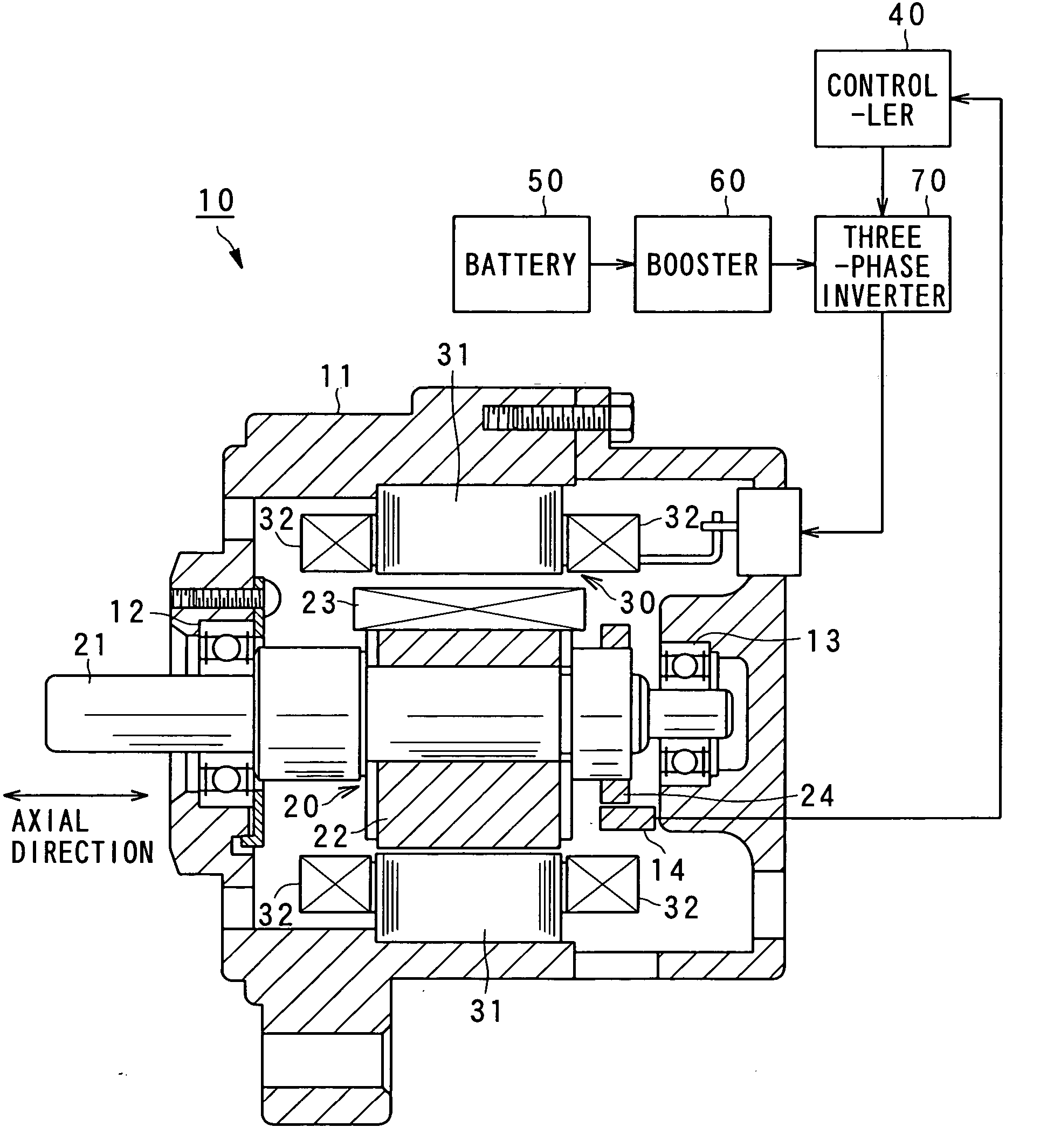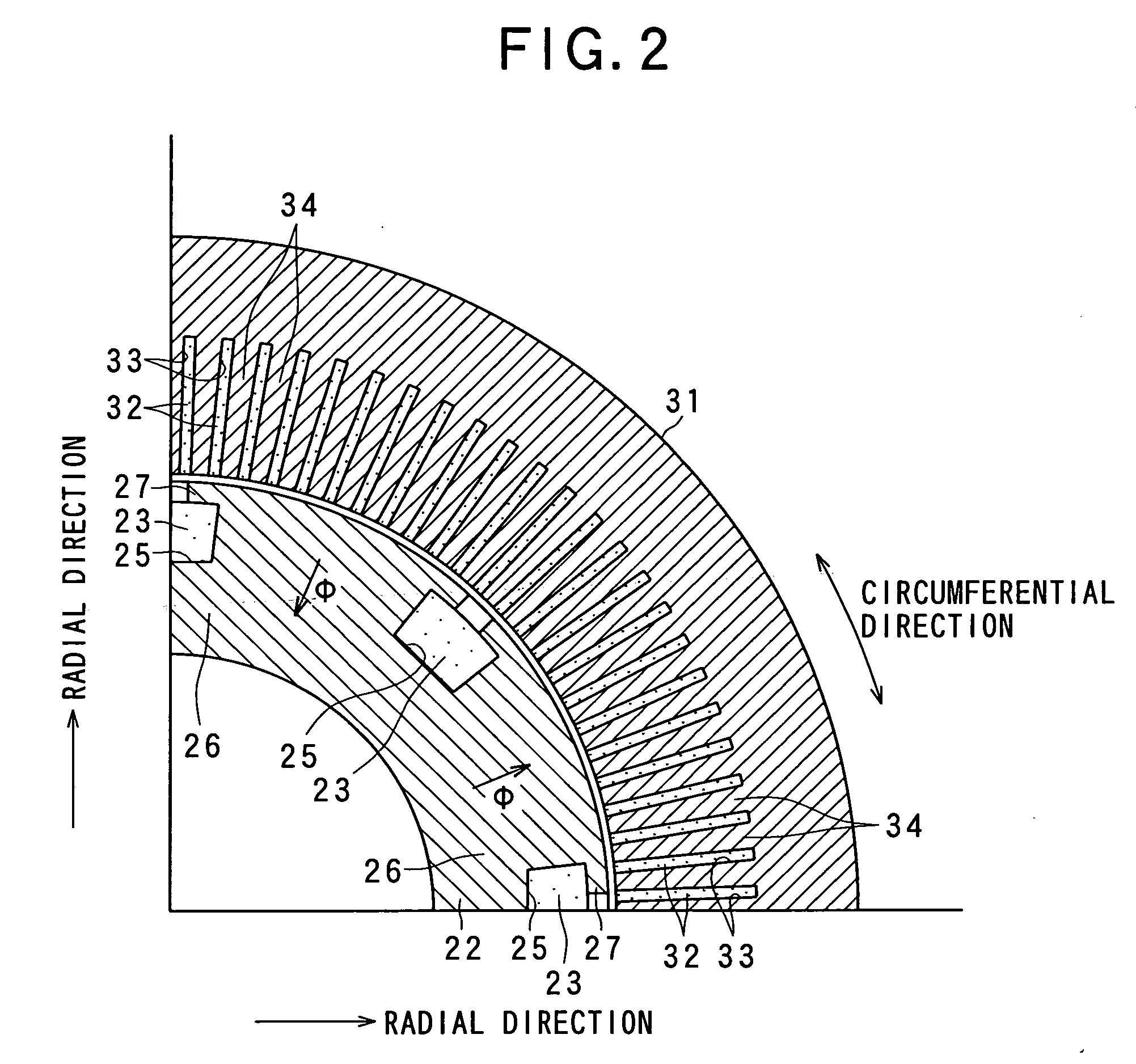Rotary electric apparatus having rotor with field winding inducing current therethrough for generating magnetic field
a rotary electric and field winding technology, applied in the direction of dynamo-electric converter control, magnetic circuit rotating parts, magnetic circuit shape/form/construction, etc., can solve the problem of large ripples in generated torque (torque ripples), and achieve the effect of preventing an increase in the magnetic resistance of the rotor cor
- Summary
- Abstract
- Description
- Claims
- Application Information
AI Technical Summary
Benefits of technology
Problems solved by technology
Method used
Image
Examples
first embodiment
[0072] Referring to FIGS. 1-19, a rotary electric apparatus according to a first embodiment of the present invention will now be described.
[0073]FIG. 1 shows the configuration of a rotary electric apparatus according to the present invention. The rotary electric apparatus includes a “synchronous motor (which is a field winding type of synchronous motor)”10 according to a first embodiment. As shown, the synchronous motor 10 is equipped with a housing 11, a rotor 20, and a stator 30.
[0074] Of these components, the rotor 20 is provided with a shaft 21, a rotor core 22, and a rotor coil 23. The shaft 21 is rotatably supported to the housing 11 with a pair of bearings 12 and 13. The shaft 21 is a cylindrical member having a predetermined length along which an axial direction can be defined, whereby a radial direction can be defined as directions perpendicular to the axial direction and a circumferential direction around the shaft 21 (refer to FIGS. 1 and 2). These primary directions ca...
second embodiment
[0124] Referring now to FIGS. 23-34, a “synchronous motor 10A” (, which is a field winding type of synchronous machine) according to a second embodiment of the present invention will be described.
[0125] In the second embodiment and subsequent embodiments and modifications, the components which are the same or identical as or to those in the first embodiment are given the same reference numerals for the sake of simplifying the description.
[0126]FIG. 23 shows a circuit diagram of the motor 10A according to the second embodiment. As shown, the equivalent circuit of the rotor 20 is expressed in a different way from that in the first embodiment.
[0127] In the rotor 20, the rotor coil 23 has no electrical connection with the battery 50 and is short-circuited by the diode 28. The rotor coil 23 has an inductance L. Both the rotor coil 23 and the diode 28 have a resistance component which can be denoted by a resistor 29 which is different from those elements 23 and 28, the resistance of wh...
third embodiment
[0188] Referring now to FIGS. 35-41, a field-winding type of synchronous machine with armature windings being powered, which is based on the present invention, will now be described.
[0189] In the third embodiment, the field-winding type of synchronous machine is reduced into practice as an on-vehicle “generator motor.” The vehicle on which the generator motor is mounted is for example a hybrid electric vehicle with a battery and an engine both serving as drive sources, an electric vehicle with a battery serving as a drive source, and a fuel-cell electric vehicle.
[0190]FIG. 36 shows a section of the generator motor 10B according to the present embodiment. The generator motor is provided with a stator 110 with a stator core 111, stator coils (i.e., stator windings) 112 wound in the stator core 111, a rotor 120 with a rotor core 121, a rotor coil (i.e., field winding) 122 wound in the rotor core 121, a rotor shaft 123, frames 131 and 132, and a position sensor 133.
[0191] The stator ...
PUM
 Login to View More
Login to View More Abstract
Description
Claims
Application Information
 Login to View More
Login to View More - R&D
- Intellectual Property
- Life Sciences
- Materials
- Tech Scout
- Unparalleled Data Quality
- Higher Quality Content
- 60% Fewer Hallucinations
Browse by: Latest US Patents, China's latest patents, Technical Efficacy Thesaurus, Application Domain, Technology Topic, Popular Technical Reports.
© 2025 PatSnap. All rights reserved.Legal|Privacy policy|Modern Slavery Act Transparency Statement|Sitemap|About US| Contact US: help@patsnap.com



